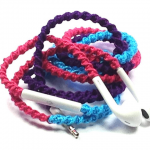We’ve reached the stage of technology where “less” is definitely considered more, and this is certainly the case with our audio experiences. Earbuds come in all shapes and sizes, and their quality is almost always contingent with a price tag. A new device is beginning to trend nicely in the market is the wireless earbud. Bluetooth seems to be all the rage nowadays, but is it your best option? Will wireless music hinder music quality? Why even go wireless? There are many advantages to going wireless. The first thing that comes to mind is that wireless earbuds simply last much longer then traditional earbuds. Now, granted, you will certainly be putting up a good amount of money at the start, but the price you pay up front is infinitesimal compared to the shelf life of the product. Traditional earbuds have wiring problems. The reason they die is usually because the wire has been wrapped and coiled so much that its innards begin to fray.
It happens to even the best of earbuds on the market. So far, the best thing about having wired earbuds is that they still deliver the most phenomenal sound at the most affordable prices. Even so, they are not immune to destruction. Wireless earbuds carry greater strength.
Furthermore, wireless technology is changing rapidly, and we’re reaching times where wireless signals are becoming severely close to wired data transfer- granted, there is still a noticeably large distance still left to cover; however, that distance is a moot point if you have the right technology in your grasp.
Unless you really don’t care much for sound, and you simply want to go wireless for the sake of not having to have the extra bulk, you’re going to want to invest in a pair of wireless earbuds that resonate with the performance we have come to love and expect; therefore, avoid Bluetooth. Bluetooth is excellent for phone calls because phone calls don’t necessarily need same the crystal clear audio that you would need if you were listening to a Coldplay CD. Most devices natively support Bluetooth because of its popularity, but we’re hoping that you decide to become a trend breaker. If you care about your music’s quality, then go get Kleer enabled wireless headsets. They are way stronger than Bluetooth enabled headsets. Their signals are very strong for distances up to 30 feet, and you really hear music close to the way it was meant to be heard. Yes, there are still going to be differences in the quality, but, unless you are an audiophile, that quality will not be too far off the mark.
Years ago, we had to worry about the battery life of such products; however pretty much anything battery operated nowadays is rechargeable. Wireless technology is changing rapidly. There really aren’t many reasons why you shouldn’t buy a pair of wireless earbuds; however, here are some “cons”- if you will:
1. They are very expensive. Even a “cheap” sounding pair will run you up a nice dollar. Just to get an iPod (not the touch or phone) Bluetooth enabled, you will need to buy an adapter that costs roughly $40, and you will need a nice pair of earbuds. Wireless bluetooh Earbuds will run you typically around $100. If you want to go the Kleer route, you’ll definitely be digging into your pockets.
2. Wireless sound still isn’t as great as wired sound; however if you buy the Kleer enabled earbuds, then you really won’t be able to tell the difference unless you have a rare gift of audio detection.
The benefits outweigh the cons:
- Lighter weight.
- Longer life.
- No wires to deal with. The only wire is the one that wraps around your neck, and you won’t be touching this.
- No “jacks” to worry about. Over time, audio plugs go bad. And, if they don’t, then your mp3 player’s audio jack can certainly get stripped from overuse. These problems don’t exist with wireless earbuds because there is nothing to plug anything into. Sure, you have your adapter that sends the audio, but that’s nothing you have to really worry about.
If you go Kleer, you will essentially have lossless audio. It’s something you really have to hear to understand.


no comment until now